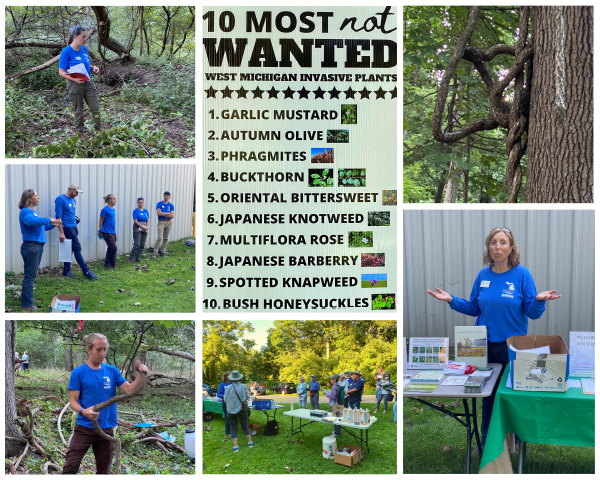AUGUST PROGRAM RECAP
Compiled by Ruth Oldenburg
Invasive Species Action: Best Practices to Protect Michigan’s Native Flora & Fauna from Intruders, presented by Jessie Schulte, District Manager, Kent Conservation District
Wild Ones and friends gathered behind Greenwood Cemetery on Leonard NW to hear Jessie Schulte and her Strike Team crew talk about invasive plants and see them growing in their habitat. Grand Rapids Parks and Recreation is responsible for 3 cemeteries, including Greenwood. The wooded area behind the cemetery has a high concentration of invasive trees, shrubs and plants—many due to neighbors dumping as well as left-over flowers from gravesites.
Jessie gave us an overview of Kent Conservation District’s work and the services it provides to the public, including the invasive Strike Team. KCD’s mission is “to protect and enhance the natural resources of Kent County.”
Attendees were divided into two groups and we walked through the woods on a path to separate stations manned by Jessie’s Strike Team crew. Along the path we saw:
- Black Snakeroot Ageratina altissima – a native plant of North America which contains poisonous toxins.
- Black Jetbead Rhodotypos scandens – introduced from eastern Asia in 1866. It grows in full sun or full shade and forms a dense shrub layer that shades out native species. This is controlled by cutting the branches an inch or so from the ground and then daubing the stumps with the herbicide STUMP STOP Cut Stump Treatment with blue dye added—so you can tell which stumps you have treated already.
- Japanese Knotweed Polygonum cuspidatum – known as “Michigan bamboo,” it is the Incredible Hulk of plants! It is so difficult to eradicate as even tiny bits of it can take root anywhere. Do not mow it (remove down) or dig it up. Report sighting to Midwest Invasive Species Network through their MISIN app. There are funds available to hire KCD Strike team to spray it with special herbicide.
- Tree of Heaven Ailanthus altissima – grows to 80 feet high and up to 6 feet in diameter and is host to the invasive spotted lantern fly. Treatment technique is called drill and fill.
- Oriental Bittersweet Celastrus orbiculatus – a climbing vine native to Eastern Asia, it was introduced in the 1860s and has been running rampant ever since. Unregulated bittersweet vines will literally take over the landscape, smothering out native species. The tangled vines can become so heavy that entire trees may be uprooted. Control methods are cutting stumps and applying herbicide, foliar spray with triclopyr, and hand pulling young vines by hand out of the ground. If fruit/seed are not present, cut vines can be left in-place to decay. Fruit/seed should be incinerated or bagged and disposed of in a landfill. Download the new KCD Bittersweet brochure.
- Chocolate vine Akebia quinata – shade tolerant invasive deciduous to evergreen climbing or trailing vine that invades forested areas in the eastern U.S. This invasive vine is an example of a perennial that has escaped to the woods and can overtake an area quickly.
- Honeysuckle Lonicera spp. – most of these species are non-native and invasive shrubs. The invasive honeysuckles have flowers and fruits all along the twigs, while native honeysuckles bear their flowers and fruits at the tip of the twigs.
- Burning bush Euonymus alatus and its cultivars seed prolifically and are becoming dominant—threatening natural areas.
At the last station we heard about the recent confirmed detection of the first sighting in Michigan of Balsam wooly adelgid in Rockford. It will be a threat to the 1.9 billion balsam firs trees in Michigan and also to the Michigan Christmas tree industry that produces 13.5 million fir trees each year.
Jessie provided an excellent handout that we used along the trail that described each of the above species. Download it here.
After the walk attendees could take home informational brochures and had the opportunity to purchase the booklet A Field ID Guide to Invasive Plants in Michigan’s Natural Communities (issued by MSU Extension and Michigan Natural Features Inventory), bottles of herbicide, and applicator bottles with sponge tips.
On behalf of Wild Ones River City Chapter, I would like to thank Jessie Schulte and the KCD Strike Team for their informative and enlightening presentation. They are enthusiastically dedicated to the cause of eliminating invasive plants in Kent County!
Email [email protected] to hire the Strike Team to eradicate invasives on your property.

